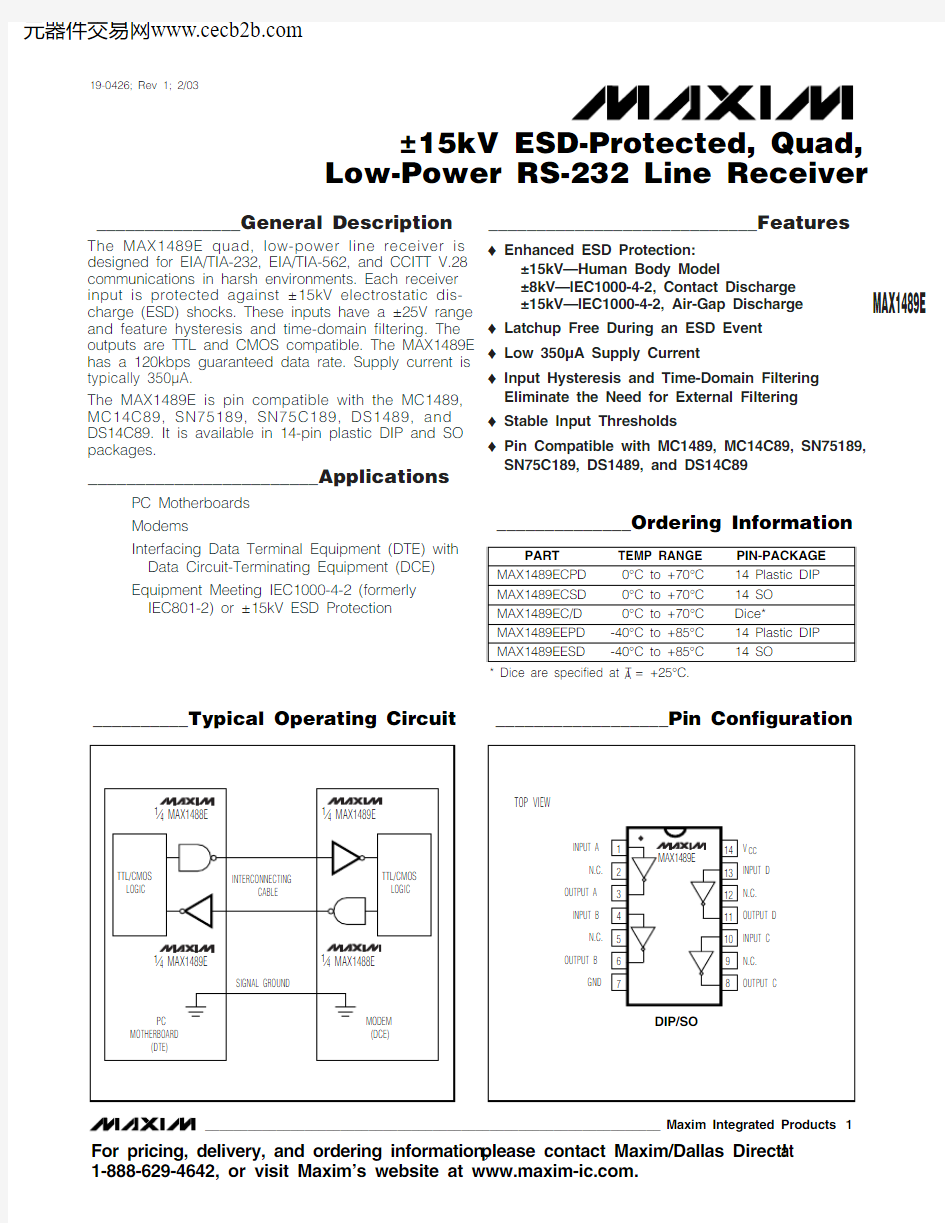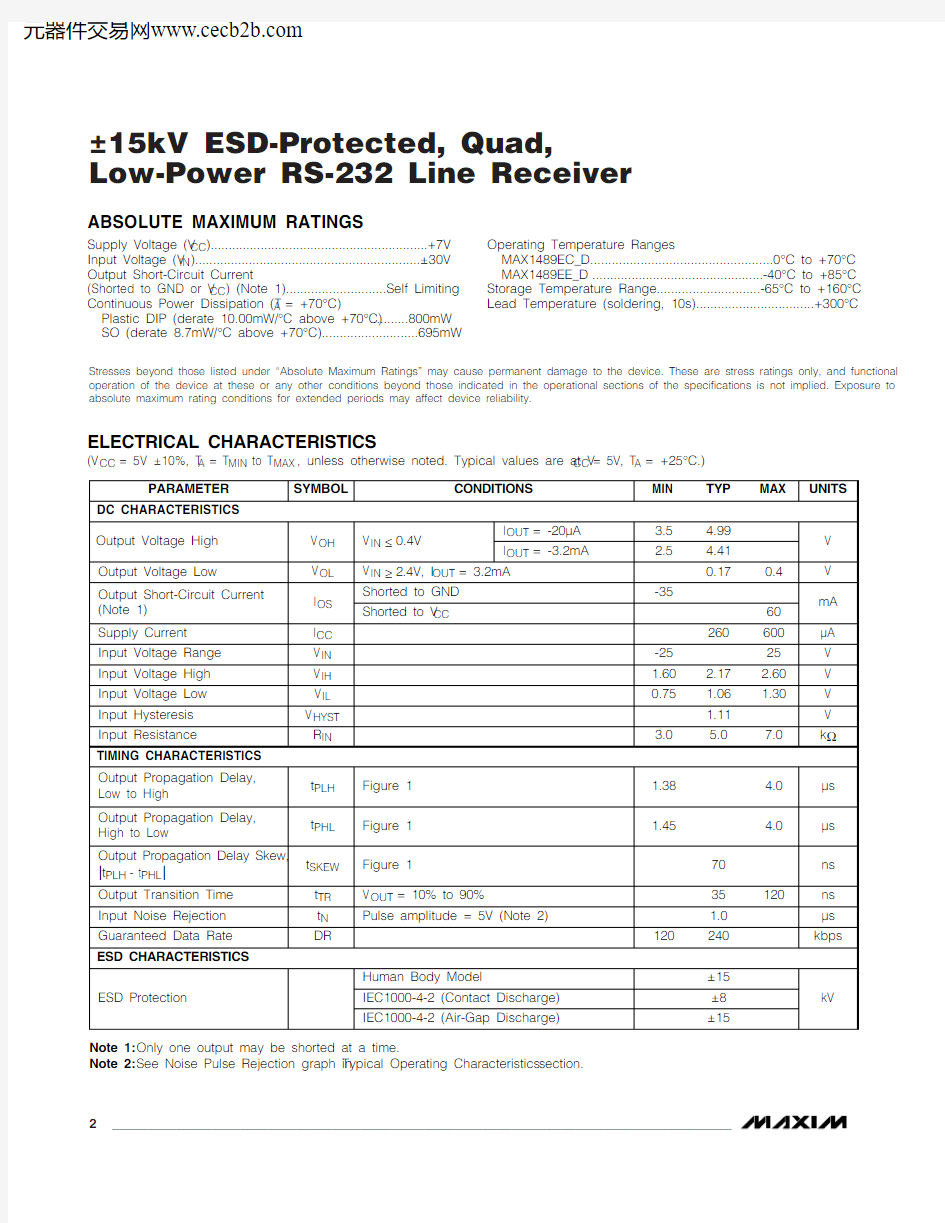MAX1489ECSD中文资料


_______________General Description
The MAX1489E quad, low-power line receiver is designed for EIA/TIA-232, EIA/TIA-562, and CCITT V.28communications in harsh environments. Each receiver input is protected against ±15kV electrostatic dis-charge (ESD) shocks. These inputs have a ±25V range and feature hysteresis and time-domain filtering. The outputs are TTL and CMOS compatible. The MAX1489E has a 120kbps guaranteed data rate. Supply current is typically 350μA.
The MAX1489E is pin compatible with the MC1489,MC14C89, SN75189, SN75C189, DS1489, and DS14C89. It is available in 14-pin plastic DIP and SO packages.
________________________Applications
PC Motherboards Modems
Interfacing Data Terminal Equipment (DTE) with Data Circuit-Terminating Equipment (DCE)Equipment Meeting IEC1000-4-2 (formerly IEC801-2) or ±15kV ESD Protection
____________________________Features
o Enhanced ESD Protection:
±15kV—Human Body Model
±8kV—IEC1000-4-2, Contact Discharge ±15kV—IEC1000-4-2, Air-Gap Discharge o Latchup Free During an ESD Event o Low 350μA Supply Current
o Input Hysteresis and Time-Domain Filtering Eliminate the Need for External Filtering o Stable Input Thresholds
o Pin Compatible with MC1489, MC14C89, SN75189,SN75C189, DS1489, and DS14C89
MAX1489E
±15kV ESD-Protected, Quad, Low-Power RS-232 Line Receiver
________________________________________________________________Maxim Integrated Products 1
__________________Pin Configuration
__________Typical Operating Circuit 19-0426; Rev 1; 2/03
* Dice are specified at T A = +25°C.
For pricing, delivery, and ordering information,please contact Maxim/Dallas Direct!at 1-888-629-4642, or visit Maxim’s website at https://www.360docs.net/doc/b07820460.html,.
M A X 1489E
±15kV ESD-Protected, Quad,
Low-Power RS-232 Line Receiver 2_______________________________________________________________________________________
ABSOLUTE MAXIMUM RATINGS
ELECTRICAL CHARACTERISTICS
(V CC = 5V ±10%, T A = T MIN to T MAX , unless otherwise noted. Typical values are at V CC = 5V, T A = +25°C.)
Stresses beyond those listed under “Absolute Maximum Ratings” may cause permanent damage to the device. These are stress ratings only, and functional operation of the device at these or any other conditions beyond those indicated in the operational sections of the specifications is not implied. Exposure to absolute maximum rating conditions for extended periods may affect device reliability.
Note 1:Only one output may be shorted at a time.
Note 2:See Noise Pulse Rejection graph in Typical Operating Characteristics section.
Supply Voltage (V CC ).............................................................+7V Input Voltage (V IN )...............................................................±30V Output Short-Circuit Current
(Shorted to GND or V CC ) (Note 1)............................Self Limiting Continuous Power Dissipation (T A = +70°C)
Plastic DIP (derate 10.00mW/°C above +70°C)..........800mW SO (derate 8.7mW/°C above +70°C)...........................695mW
Operating Temperature Ranges
MAX1489EC_D...................................................0°C to +70°C MAX1489EE_D ................................................-40°C to +85°C Storage Temperature Range.............................-65°C to +160°C Lead Temperature (soldering, 10s).................................+300°C
MAX1489E
±15kV ESD-Protected, Quad, Low-Power RS-232 Line Receiver
_______________________________________________________________________________________3
0.6-40
PROPAGATION DELAY vs. TEMPERATURE
1.0
M A X 1489E -01
TEMPERATURE (°C)
P R O P A G A T I O N D E L A Y (μs )
60
1.81.4
-15
35
85
2.210
t PHL
t PLH
0-40
PROPAGATION DELAY SKEW
vs. TEMPERATURE
200
TEMPERATURE (°C)
P R O P A G A T I O N D E L A Y S K E W (n s )
60
600
400
-15
35
85
80010
00.7
NOISE PULSE REJECTION
2
INPUT PULSE WIDTH (μs)
I N P U T P U L S E A M P L I T U D E (V p -p )
2.3
6
4
1.1
1.9
2.7
8 1.5
_____________________Pin Description
__________________________________________Typical Operating Characteristics
(V CC = 5V, T A = +25°C, unless otherwise noted.)
Figure 1. Timing Diagram
M A X 1489E
_______________Detailed Description
±15kV ESD Protection
As with all Maxim devices, ESD protection structures are incorporated on all pins to protect against electro-static discharges encountered during handling and assembly. The MAX1489E receiver inputs have extra protection against static electricity found in normal operation. Maxim’s engineers developed state-of-the-art structures to protect these pins against ESD of ±15kV without damage. After an ESD event, the MAX1489E keeps working without latchup.
ESD protection can be tested in various ways; the receiver inputs are characterized for protection to the following:
1)±15kV using the Human Body Model
2)±8kV using the Contact Discharge method speci-fied in IEC1000-4-2 (formerly IEC801-2)
3)±15kV using the Air-Gap Discharge method speci-fied in IEC1000-4-2 (formerly IEC801-2).ESD Test Conditions
Contact Maxim for a reliability report that documents test setup, methodology, and results.
Human Body Model
Figure 2a shows the H uman Body Model, and Figure 2b shows the current waveform it generates when dis-charged into a low impedance. This model consists of a 100pF capacitor charged to the ESD voltage of inter-est, which is then discharged into the test device through a 1.5k ?resistor.
IEC1000-4-2
The IEC100-4-2 standard covers ESD testing and per-formance of finished equipment; it does not specifically refer to integrated circuits. The MAX1489E helps you design equipment that meets Level 4 (the highest level)of IEC1000-4-2, without additional ESD protection com-ponents.
The major difference between tests done using the Human Body Model and IEC1000-4-2 is higher peak cur-rent in IEC1000-4-2. Because series resistance is lower in the IEC1000-4-2 ESD test model (Figure 3a), the ESD withstand voltage measured to this standard is generally lower than that measured using the Human Body Model.Figure 3b shows the current waveform for the ±8kV IEC1000-4-2 Level 4 ESD Contact Discharge test.The Air-Gap test involves approaching the device with a charged probe. The Contact Discharge method connects the probe to the device before the probe is energized.
±15kV ESD-Protected, Quad,
Low-Power RS-232 Line Receiver 4_______________________________________________________________________________________
Figure 2a.Human Body ESD Test Model Figure 2b.Human Body Model Current Waveform
Machine Model
The Machine Model for ESD testing uses a 200pF stor-age capacitor and zero-discharge resistance. Its objec-tive is to mimic the stress caused by contact that occurs with handling and assembly during manufactur-ing. Of course, all pins (not just RS-232 inputs and out-puts) require this protection during manufacturing.Therefore, the Machine Model is less relevant to the I/O ports than the Human Body Model and IEC1000-4-2.
__________Applications Information
Use proper layout to ensure other devices on your board are not damaged in an ESD strike. Currents as high as 60A can instantaneously pass through the ground pin, so it is important to minimize the ground-lead return path to the power supply. A separate return path to the power supply is recommended. Trace widths should be greater than 40 mils. V CC must be bypassed with 0.1μF capacitors as close to the part as possible to ensure maximum ESD protection.
MAX1489E
±15kV ESD-Protected, Quad, Low-Power RS-232 Line Receiver
_______________________________________________________________________________________5
Figure 3a.IEC1000-4-2 ESD Test Model Figure 3b.IEC1000-4-2 ESD Generator Current Waveform
M A X 1489E
±15kV ESD-Protected, Quad,
Low-Power RS-232 Line Receiver 6_______________________________________________________________________________________
___________________Chip Topography
TRANSISTOR COUNT: 144
SUBSTRATE CONNECTED TO GND
INPUT D
OUTPUT B
0.096"(2.438mm)
0.071"(1.803mm)
GND OUTPUT D
INPUT C
OUTPUT C
V INPUT B
OUTPUT A
INPUT A
MAX1489E
±15kV ESD-Protected, Quad, Low-Power RS-232 Line Receiver
_______________________________________________________________________________________7
Package Information
(The package drawing(s) in this data sheet may not reflect the most current specifications. For the latest package outline information,go to https://www.360docs.net/doc/b07820460.html,/packages .)
Maxim cannot assume responsibility for use of any circuitry other than circuitry entirely embodied in a Maxim product. No circuit patent licenses are implied. Maxim reserves the right to change the circuitry and specifications without notice at any time.
8___________________Maxim Integrated Products, 120 San Gabriel Drive, Sunnyvale, CA 94086 (408) 737-7600?2003 Maxim Integrated Products
Printed USA
is a registered trademark of Maxim Integrated Products.
M A X 1489E
±15kV ESD-Protected, Quad,
Low-Power RS-232 Line Receiver
Package Information (continued)
(The package drawing(s) in this data sheet may not reflect the most current specifications. For the latest package outline information,go to https://www.360docs.net/doc/b07820460.html,/packages .)
